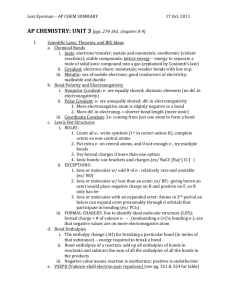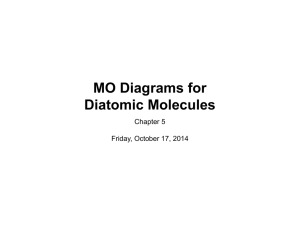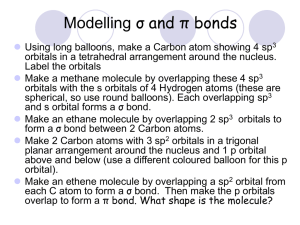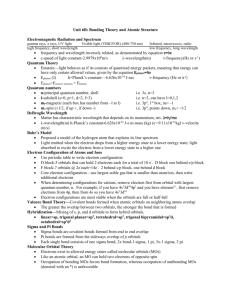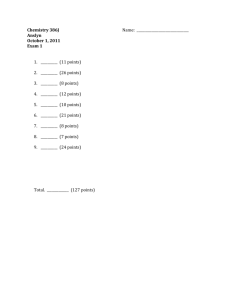Ch 10 Molecular Geometry
advertisement
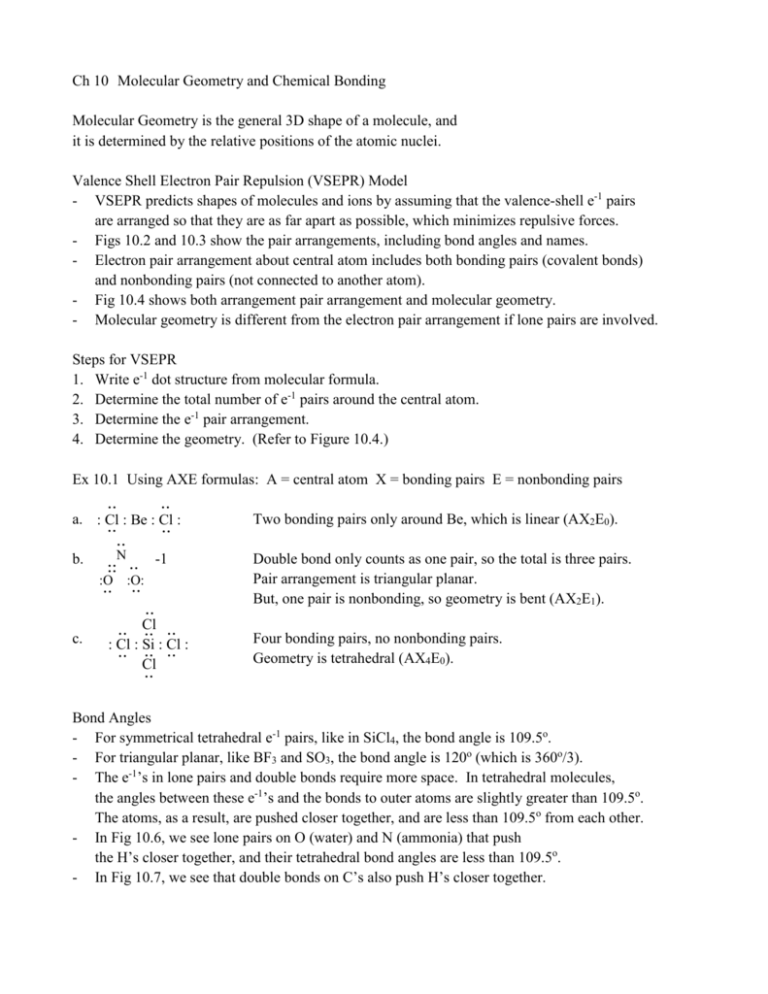
Ch 10 Molecular Geometry and Chemical Bonding Molecular Geometry is the general 3D shape of a molecule, and it is determined by the relative positions of the atomic nuclei. Valence Shell Electron Pair Repulsion (VSEPR) Model - VSEPR predicts shapes of molecules and ions by assuming that the valence-shell e-1 pairs are arranged so that they are as far apart as possible, which minimizes repulsive forces. - Figs 10.2 and 10.3 show the pair arrangements, including bond angles and names. - Electron pair arrangement about central atom includes both bonding pairs (covalent bonds) and nonbonding pairs (not connected to another atom). - Fig 10.4 shows both arrangement pair arrangement and molecular geometry. - Molecular geometry is different from the electron pair arrangement if lone pairs are involved. Steps for VSEPR 1. Write e-1 dot structure from molecular formula. 2. Determine the total number of e-1 pairs around the central atom. 3. Determine the e-1 pair arrangement. 4. Determine the geometry. (Refer to Figure 10.4.) Ex 10.1 Using AXE formulas: A = central atom X = bonding pairs E = nonbonding pairs .. .. .. a. : Cl : Be : Cl : .. .. N b. .. .. .. -1 :O :O: .. .. .. Cl .. .. .. c. : Cl : Si .. : .. .. : Cl Cl .. Two bonding pairs only around Be, which is linear (AX2E0). Double bond only counts as one pair, so the total is three pairs. Pair arrangement is triangular planar. But, one pair is nonbonding, so geometry is bent (AX2E1). Four bonding pairs, no nonbonding pairs. Geometry is tetrahedral (AX4E0). Bond Angles - For symmetrical tetrahedral e-1 pairs, like in SiCl4, the bond angle is 109.5o. - For triangular planar, like BF3 and SO3, the bond angle is 120o (which is 360o/3). - The e-1’s in lone pairs and double bonds require more space. In tetrahedral molecules, the angles between these e-1’s and the bonds to outer atoms are slightly greater than 109.5o. The atoms, as a result, are pushed closer together, and are less than 109.5o from each other. - In Fig 10.6, we see lone pairs on O (water) and N (ammonia) that push the H’s closer together, and their tetrahedral bond angles are less than 109.5o. - In Fig 10.7, we see that double bonds on C’s also push H’s closer together. Exceptions to Octet Rule ( >8 e-1 around central atom) - Five pairs of e-1’s is the trigonal bipyramidal arrangement. Refer to Fig 10.8. This arrangement has two kinds of e-1 pairs. The three pairs in one plane are equatorial, and are 120o apart. The two pairs perpendicular to the other 3 are axial, and are 90o away from equatorial. - Six pairs of e-1’s is the octahedral pair arrangement. Equatorial and axial are indistinguishable. All bond angles are 90o. Ex 10.2 Molecular Geometry for an Exception to the Octet Rule (TeCl4) - Te has six valence e-1, and with one more from each Cl, the total is ten e-1’s, or five pairs. - One pair is nonbonding, so the molecule is AX4E1 and has see-saw geometry. - Two of the Cl’s are equatorial (middle), and the other two are axial (top and bottom). Dipole Moment - The dipole moment is the charge separation in a polar molecule. It is found by charge times distance. - Result is Coulomb-meters (C-m), which can be converted to Debyes: 1 Debye = 3.34 × 10-30 C-m. - It is caused by differences in e/n between two bonded atoms - that is their bond polarity. - It can be reinforced or cancelled by molecular geometry. - O=C=O is linear, so the two polarities cancel completely, and the molecule is nonpolar. - H2O is polar because both H’s are approximately on the same side of the O. Ex 10.3 Dipole Moment as a Function of Molecular Geometry - SO2 is AX2E1, which is bent, not linear. The oxygen atoms do not cancel each other, and the molecule is polar. - NF3 is AX3E1, which is trigonal pyramidal. The three F’s do not cancel each other, and the molecule is polar. - BF3 is AX3E0, which is triangular planar. The three F’s do cancel each other, and this molecule is nonpolar. Intermolecular Forces - Polar molecules orient themselves in liquid and solid phases. As a result, they have higher intermolecular forces than nonpolar molecules. That is, the molecules are held together more strongly. - Polar liquids generally have higher boiling points than nonpolar liquids. For example, see the cis and trans dichloroethene molecules at the end of section 10.2. The cis molecule is polar, and the trans molecule is nonpolar. The polar molecule (cis) has the higher boiling point. Valence Bond Theory (explains covalent bonding with quantum mechanics) 1. An orbital from one atom occupies the same space as an orbital from an adjoining atom. This is called overlap. 2. The total number of e-1’s for both orbitals combined is no more than two. That is, the two orbitals share the two e-1’s. Hybrid Orbitals - Hybrid orbitals are combinations of atomic orbitals from more than one subshell. - Hybridization of different types of orbitals creates a set of composite orbitals which all have the same shape, size, and energy. - The hybrid orbitals’ shape, size, and energy are essentially averages of all of the component orbitals’ shape, size, and energy. - The total number of orbitals does not change. - Hund’s rule predicts that an orbital with two e-1’s will donate one e-1 to an empty orbital which has the same energy. - As a result, hybridization maximizes the number of half-filled orbitals which are available to form covalent bonds - The name of the hybrid orbital type uses the component orbitals, along with superscripts denoting the number of orbitals from that subshell. For instance, one s orbital and three p orbitals will form four identical (averaged) sp3 orbitals. - Carbon has four valence orbitals in two subshells. They contain four valence e-1’s, and their unhybridized configuration is 2s22p2. This configuration has only two unpaired e-, which could only form two normal covalent bonds. But, carbon can actually form four. - The s orbital can hybridize with up to three p orbitals. The s orbital, along with three p orbitals, will form four sp3 orbitals, and each hybridized orbital will have one unpaired e-1. - The sp3 configuration forms four identical normal covalent bonds in compounds such as CH4. These bonds are also equally spaced apart, so that the geometry is tetrahedral (109.5o). - Table 10.2 lists common types of hybrid orbitals, along with their pair arrangements. If the pair arrangement is determined from dot structure using the VSEPR method, the hybridization can then be predicted from the table. Ex 10.4 Valence Bond Theory for H2O - The O in H2O is AX2E2, which has a bent geometry and a tetrahedral pair arrangement. - From Table 10.2, this implies sp3 hybridization. - Since O has six valence e-1’s. So, there are two filled sp3 orbitals that are nonbonding, and two sp3 orbitals with one e-1 each, which form the two covalent bonds with H’s. Ex 10.5 Valence Bond Theory for Exceptions to the Octet Rule - The Xe in XeF4 a total of six e-1 pairs, as seen in example 9.10 (see chapter 9 notes). - XeF4 is AX4E2 and has square planar geometry. - Six e-1 pairs have an octahedral pair arrangement and can result from sp3d2. Two of the five orbitals in the 5d subshell are included in sp3d2. - Xe owns eight valence e-1’s. So, there are two filled nonbonding sp3d2 orbitals, and four sp3d2 orbitals with one e-1 each, which form four covalent bonds with F’s. Multiple Bonds - More than one orbital from each atom has to overlap. - The 2nd and 3rd e-1 pairs of double and triple bonds use only unhybridized p orbitals. - Only the p orbitals not involved with these bonds can now hybridize with the s orbital. One of those hybridized orbitals is then used for the 1st e-1 pair of the multiple bond. The remaining hybridized orbitals are used to bond with the remaining atoms. - In H2C::CH2, the 2nd e-1 pair of the double bond uses unhybridized p orbitals from each C. The 2nd bond overlaps the two-lobed p orbitals to create a (pi) bond, as in Figure 10.25C. - This leaves two 2p orbitals and one 2s orbital to hybridize as three sp2 orbitals. The three sp2 orbitals create three (sigma) bonds to the other C and the two H’s. These bonds have trigonal planar geometry, and are 120o apart, as in Figure 10.26A. - In HC:::CH, the 2nd and 3rd e-1 pairs of the triple bond use unhybridized p orbitals from each C. So, the 2nd and 3rd e-1 pairs create two bonds, as in Figure 10.27B. - This leaves one 2p orbital and one 2s orbital to hybridize as two sp orbitals. The two sp orbitals create two (sigma) bonds, one with the other C and one with the H. These bonds have linear geometry, and are 180o apart, as in Figure 10.27A. Ex 10.6 Valence Bond Theory for Multiple Bonds - The N’s in N2F2 share two e-1 pairs. Each N is AX2E1. So, N2F2 has a trigonal planar pair arrangement and a bent geometry. - Like H2C::CH2, the 2nd e-1 pair creates a bond using unhybridized 2p orbitals, leaving three sp2 orbitals that are formed from the remaining two 2p orbitals and one 2s orbital. - Two of the three sp2 orbitals on each N create two bonds (to N and to F). The third sp2 orbital exists as a nonbonding (lone) pair. Isomers - Isomers are compounds with the same molecular formula, but different arrangements of the atoms. - Isomers can be divided into two types: constitutional and geometric. - Constitutional isomers have different atomic bonding, like CH3CH2OH and CH3OCH3. - Geometric isomers have the same atomic bonds, but different spatial arrangements. - Cis and trans dichloroethene (sections 10.2 and 10.3) are geometric isomers due to different spatial arrangements of atoms next to the double bonded C’s. - Optical isomers are a type of geometric isomerism resulting from molecules with bonds which cause them to be mirror images of each other. See lactic acid in Figure 10.15.


